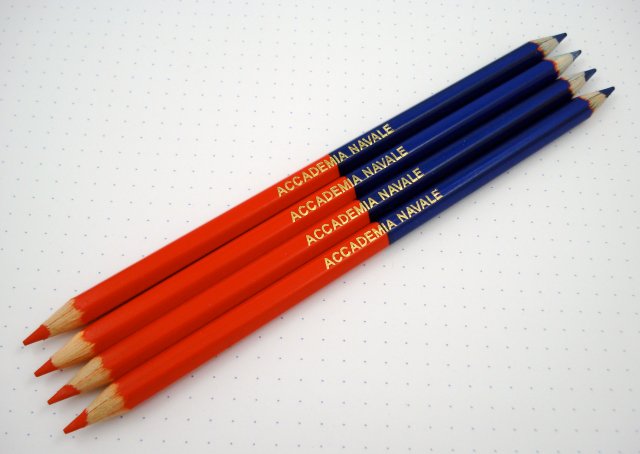
A curiosity from eBay, this box of Koh-I-Noor 3433 red and blue pencils has a surprise – the pencils are marked Accademia Navale.

I’d love to know the whole story. They certainly are an impressive looking stationery staple.


pencil talk | pencil reviews and discussion
exploring the art and science of pencils since 2005

A curiosity from eBay, this box of Koh-I-Noor 3433 red and blue pencils has a surprise – the pencils are marked Accademia Navale.

I’d love to know the whole story. They certainly are an impressive looking stationery staple.

First, an apology. I only recently became fully aware that since a hosting change, the blog has lost full support for international languages. This is unfortunate, since a number of previous posts and comments that discussed the translation of pencil nomenclature (often Japanese to English) no longer make sense. If you might know the solution, or have a clue or hint, it would be appreciated.
The immediate problem is that it seems that the blog can’t 100% accurately render the name of the UNESCO World Heritage Site that is the home of Koh-I-Noor Hardmuth.
Koh-I-Noor is a major and important pencil company that I regret has received insufficient coverage at pencil talk. In the blog’s defense, their products are often quite difficult to obtain in Canada. Koh-I-Noor is a rival of Bic/Conté in being able to trace their history back to the origins of modern pencil making. I don’t know what records or archives they have been able to maintain, but hope a professional historian will someday be able to recount their story.
These pencils came from the best online source for European pencils that I’m aware of, Bundoki.com. Bundoki staff visited a number of European manufacturers in 2010, and picked up several goodies they have kindly made available to the rest of us.
This particular pencil is a special “home edition” or some something along those lines. Hexagonal and oversized with an oversize lead, with natural finish, it is a very impressive pencil.
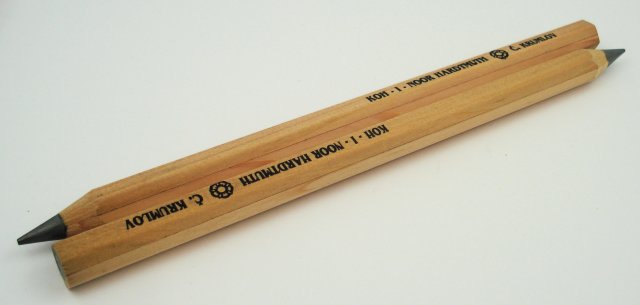
Details of the imprint:

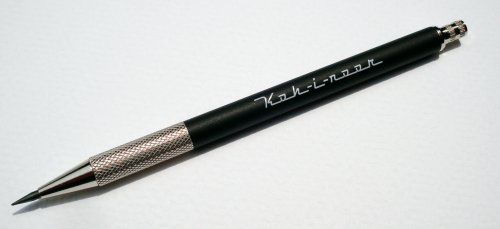
The leadholders
From Koh-I-Noor we have the Toison D’Or 5900 and 5608 2.0mm leadholders. In an accompanying role are Koh-I-Noor colour leads.
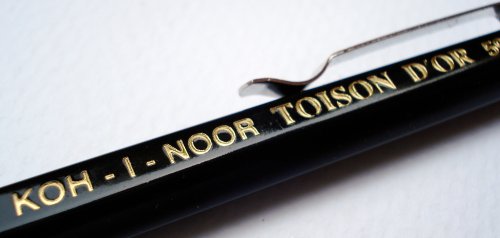
The 5900 is a leadholder which seems to be modelled on the Toison d’Or woodcase pencil. The weight and hardness of the body suggest metal composition, but I could be wrong.
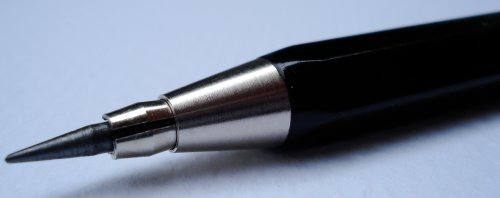
It has a clip stamped “Koh-I-Noor”. The clip edges are rough to the touch, and appear very cheap.
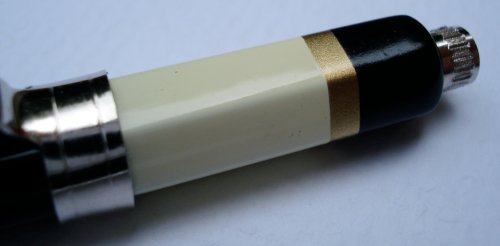
The cap unscrews and revels four extended blades which form a sharpener. Clever, it works, though not as well as a standard format sharpener.
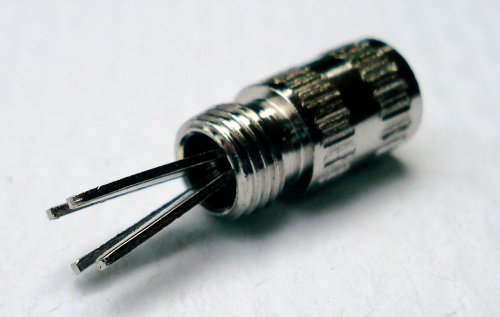

The 5608 (top photo) is something new. Sleek and svelte, it is really a 2.0mm mechanical pencil in a very portable format. The Toison d’Or’s awkward stamping is replaced with a retro rendering of the Koh-I-Noor name. Nice!

It also has a cap with a four-blade sharpener. Unfortunately, there is a problem. The 5608’s sharpener can’t sharpen the pencil’s lead since the pencil lacks the ability to grip the lead during sharpening – the lead just spins and spins around. Other blog posts have noted that this problem is shared with other large diameter lead mechanical pencils. This also prohibits the lead from being sharpener with other sharpeners while the lead remains in the pencil.
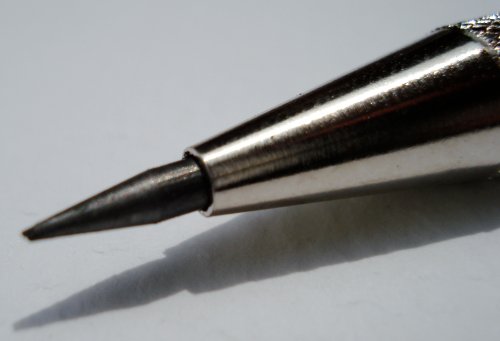
The leads
Colour lead in wide lead sizes (2.0, 3.15, and 5.6 mm diameters) can be a great joy – easy to use, and allowing great control. Unfortunately, it can also be hard to find and expensive.
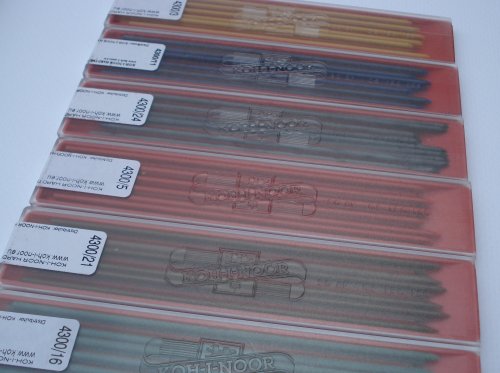
Koh-I-Noor’s leads were a delight to discover, due to the range of colours and the richness of the lines.
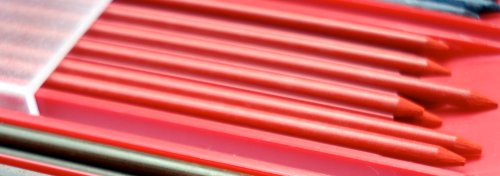
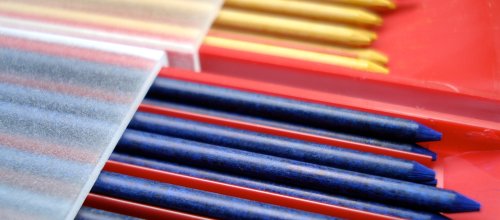
For a few days, I thought I had discovered an exceptional stationery item.
Sample marks on both a toothy artist paper from Canson, and a Marumann notebook:


Then something happened. A lead snapped, jamming the containing leadholder. While I’m not an expert, I know this is very odd – leadholders have very simple mechanisms – they are essentially a “clutch” surrounding a tube for the lead – and they don’t jam. Then another leadholder jammed. Something was very odd about this lead.
I thought the 5608 might be a great document review pencil with a blue lead – but to my frustration, the lead wouldn’t go in the pencil. That was the clue and the answer – this wasn’t really 2.0mm lead!
I took out the micrometer, and a few samples of Koh-I-Noor lead averaged 2.13mm in diameter. For a reference, I tried measuring a Mitsubishi Uni lead sample – that was 2.01mm.
The Koh-I-Noor lead is significantly off specification! It won’t fit even in the manufacturer’s own pencil – nor can the lead fit in standard KUM/Staedtler/Faber-Castell lead sharpeners (I have tried). It further creates complications in standard 2.0mm leadholders.
Though the colours are nice, I am very disappointed with this offering. Koh-I-Noor is a mainstay of drafting, drawing, and writing supplies that I admire, but it looks like the design department got the whole budget for these products, while engineering was neglected.

A recent (excellent) post at Timberlines made me think of these pencils. I had bought a box of “vintage” pencils via an online auction site whose name begins with “E”. The slightly padded envelope in which they arrived hadn’t stopped the cardboard pencil box from arriving with all corners broken. Also, the box was precisely seven twelfths full. Anyhow, sometimes you have to look on the bright side – they are still interesting (and historic) pencils, and less expensive than seven new pencils from any quality manufacturer. In fact they were less than seven new Koh-I-Noor pencils would cost me.
The box is cardboard, with the Koh-I-Noor emblem on the cover, and marked “1561 mittel” and “L & C. Hardmuth” on the sides. The pencils are yellow, with gold stamping:
L. & C. HARDMUTH "KOH-I-NOOR" KOPIERSTIFT * 1561 * MITTEL
Unlike the text on the box, there is a period after the “L”. The box is additionally marked inside “Koh-I-Noor Bleistiftfabrik”. I believe that “Kopierstift” roughly translates to what would be known as a copying or indelible pencil, and “mittel” to middle. “Bleistiftfabrik” is pencil factory. Cool!
Picking one up, the first thing I noticed was that these pencils are larger than modern round pencils, such as the Faber-Castell 9008. The core also seems much wider.
The next step required some debate. Although I could see arguments for preserving them, there was also another side. These pencils were made by craftsmen across an ocean and across a generation. I would assume they wanted their product used. So – I got out the sharpener.
My first thought was – “wow, I just sharpened a really old pencil.” The larger pencil width seemed to produce a longer point than other pencils in my sharpener (a Faber-Castell UFO). The two halves of the casing also seemed quite visible.
Writing on a Rhodia pad, I wrote a few lines. I also tried a modern Koh-I-Noor for comparison. The pencil writes smoothly and reliably, similar to many other quality pencils. The lead seems quite strong. I also tried erasing my writing. It is definitely a copying pencil, and resists vinyl erasers! Only my black Factis (meant for charcoal) erased the lines of the 1561.
I thought I was done, and was going to post what I had written – but I hadn’t yet discovered the most interesting part of this pencil. After sharpening the pencil, trying it out, and writing the above notes (with the pencil), I noticed some graphite dust on my hands. When I went to wash up, the dust turned a brilliant purple. I had never seen this before from a pencil. A little searching on the web turned up this excellent article on copying pencils from an American Institute for Conservation publication. The purple had come from a dye – an “aniline dye” that was created from coal tar by-products.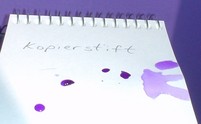
An original use of these pencils was placing a damp tissue above the pencil writing to take a copy. For anyone old enough to remember a ditto machine from high school (remember the smell of a fresh ditto?), these pencils seem like a manual predecessor. They’re also associated with copy presses and were used with carbon paper. The “indelible” function took over at some point as the main use and selling point.
I tried to moisten some paper and press it against my notes to take a copy. It transferred very roughly, and I can see that with some practice and a careful choice of paper and moistenening methods, it would be a useable method.
It struck me as quite amazing that this ordinary looking yellow pencil was capable of so much.